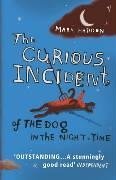All Nonfiction
- Bullying
- Books
- Academic
- Author Interviews
- Celebrity interviews
- College Articles
- College Essays
- Educator of the Year
- Heroes
- Interviews
- Memoir
- Personal Experience
- Sports
- Travel & Culture
All Opinions
- Bullying
- Current Events / Politics
- Discrimination
- Drugs / Alcohol / Smoking
- Entertainment / Celebrities
- Environment
- Love / Relationships
- Movies / Music / TV
- Pop Culture / Trends
- School / College
- Social Issues / Civics
- Spirituality / Religion
- Sports / Hobbies
All Hot Topics
- Bullying
- Community Service
- Environment
- Health
- Letters to the Editor
- Pride & Prejudice
- What Matters
- Back
Summer Guide
- Program Links
- Program Reviews
- Back
College Guide
- College Links
- College Reviews
- College Essays
- College Articles
- Back
The Curious Incident of the Dog in the Night-time by Mark Haddon
The Curious Incident of the Dog in the Night-time
2, 3, 5, 7, 11, 13, 17, 19, 23, etc. - you many think these are simply prime numbers, but they are also the chapter for Mark Haddon’s unique novel, The Curious Incident of the Dog in the Night-time. This ingenious novel, written from the perspective of a 15-year-old autistic boy, guides you through the creative mindset of Christopher while he tries to solve the murder mystery of his neighbor’s dog. Ultimately he uncovers more about his family than intended and takes a frightful journey alone when his survival instincts kick in. Throughout the twists and turns of the book, Christopher discovers newfound strength within him and logically approaches each problem he faces.
As a young adult, Mark Haddon worked with autistic people; providing him with a background on how to construct his main character, Christopher. Haddon also inserted his own belief of atheism into Chris, and based his viewpoints primarily on logic. He even goes as far as claiming that “there is life on earth because of an accident” (pg. 164) and that “people believe in God because the world is very complicated” and a divine power seems like a reasonable explanation, but once again Christopher refutes this possibility completely. Mark Haddon uses his past experience with autistic people to instill his own ideas into Chris, but in an extremely effective and believable way.
Although Christopher’s inclusion of charts and theories may seem random, Haddon efficiently alternates content in his chapters; switching between the story and other interesting facts that Christopher may be thinking. The entire time he speaks in stream of consciousness which gives a better glimpse of the thoughts in Christopher’s brain. Haddon includes lists and diagrams in the middle of sentences, almost in the place of syntax like a visual representation he configures in his head. One of the intriguing arguments he explains is The Monty Hall Problem, by drawing out the possibilities a game show offers. These helpful insights make the book more exciting and entertaining.
Christopher’s character “[does] not tell lies,” and this is because “[he can’t] tell lies” (pg. 37). Many of the problems he deals with arise because he always tells the truth and can’t hide what he’s feeling. He couldn’t disclose the secret that he found the letters his mother had sent him, and he reacted purely on instinct; “[he] rolled on the bed and curled up in a ball” (pg. 113). When his father realized that Christopher knew about the letters, he then spilled all his secrets at once, which of course scared Chris into running away, moving the storyline like a domino effect- each event spurring the next. Haddon strung these situations together so seamlessly that the story is both understandable and captivating. In essence, the entire book is almost a coincidence, beginning with the curious incident of the dog in the night-time.
Similar Articles
JOIN THE DISCUSSION
This article has 0 comments.

